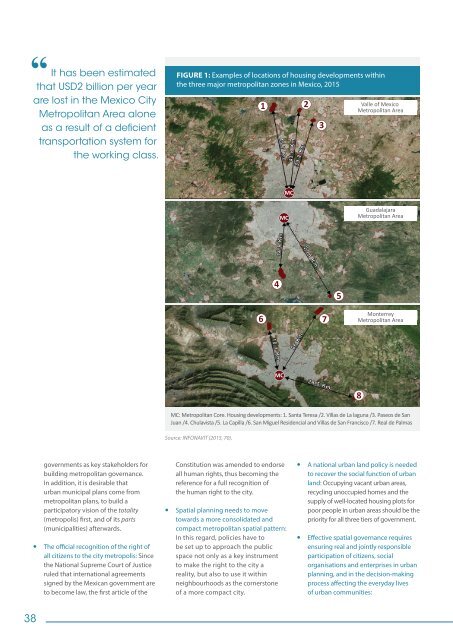A new urban paradigm pathways to sustainable development
PiF37
PiF37
Create successful ePaper yourself
Turn your PDF publications into a flip-book with our unique Google optimized e-Paper software.
“<br />
It has been estimated<br />
that USD2 billion per year<br />
are lost in the Mexico City<br />
Metropolitan Area alone<br />
as a result of a deficient<br />
transportation system for<br />
the working class.<br />
FIGURE 1: Examples of locations of housing <strong>development</strong>s within<br />
the three major metropolitan zones in Mexico, 2015<br />
1<br />
2<br />
3<br />
Valle of Mexico<br />
Metropolitan Area<br />
MC<br />
MC<br />
Guadalajara<br />
Metropolitan Area<br />
4<br />
5<br />
6 7<br />
Monterrey<br />
Metropolitan Area<br />
MC<br />
8<br />
MC: Metropolitan Core. Housing <strong>development</strong>s: 1. Santa Teresa /2. Villas de La laguna /3. Paseos de San<br />
Juan /4. Chulavista /5. La Capilla /6. San Miguel Residencial and Villas de San Francisco /7. Real de Palmas<br />
Source: INFONAVIT (2015, 70).<br />
governments as key stakeholders for<br />
building metropolitan governance.<br />
In addition, it is desirable that<br />
<strong>urban</strong> municipal plans come from<br />
metropolitan plans, <strong>to</strong> build a<br />
participa<strong>to</strong>ry vision of the <strong>to</strong>tality<br />
(metropolis) first, and of its parts<br />
(municipalities) afterwards.<br />
y • The official recognition of the right of<br />
all citizens <strong>to</strong> the city metropolis: Since<br />
the National Supreme Court of Justice<br />
ruled that international agreements<br />
signed by the Mexican government are<br />
<strong>to</strong> become law, the first article of the<br />
Constitution was amended <strong>to</strong> endorse<br />
all human rights, thus becoming the<br />
reference for a full recognition of<br />
the human right <strong>to</strong> the city.<br />
• y Spatial planning needs <strong>to</strong> move<br />
<strong>to</strong>wards a more consolidated and<br />
compact metropolitan spatial pattern:<br />
In this regard, policies have <strong>to</strong><br />
be set up <strong>to</strong> approach the public<br />
space not only as a key instrument<br />
<strong>to</strong> make the right <strong>to</strong> the city a<br />
reality, but also <strong>to</strong> use it within<br />
neighbourhoods as the corners<strong>to</strong>ne<br />
of a more compact city.<br />
• y A national <strong>urban</strong> land policy is needed<br />
<strong>to</strong> recover the social function of <strong>urban</strong><br />
land: Occupying vacant <strong>urban</strong> areas,<br />
recycling unoccupied homes and the<br />
supply of well-located housing plots for<br />
poor people in <strong>urban</strong> areas should be the<br />
priority for all three tiers of government.<br />
• y Effective spatial governance requires<br />
ensuring real and jointly responsible<br />
participation of citizens, social<br />
organisations and enterprises in <strong>urban</strong><br />
planning, and in the decision-making<br />
process affecting the everyday lives<br />
of <strong>urban</strong> communities:<br />
38


